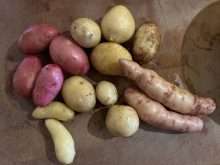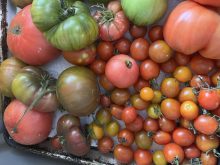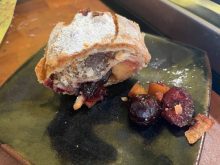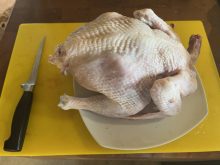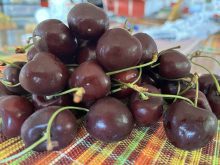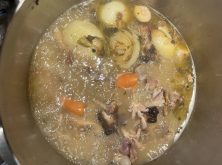What a pleasant surprise I had recently. Jim Hyrich, known as Jim, the Pie Guy, came by one day while I was away for a short time. In my absence he left some of his homemade flapper pie, along with an attached note: “Ted. These are a couple slices of my flapper pie. I am trying to tweak my recipe somewhat and did not want to pig out and eat the whole pie, so I am bringing you a couple slices to get your professional opinion. (signed) The Pie Guy, Jim.”
Jim is a multi-talented, self-employed entrepreneur who in my opinion would do really well if he had his own bakeshop and specialized in pies and tarts. As a matter of fact, more than once Jim has supplied me with homemade saskatoon pies and butter tarts at a reasonable price, made with Canadian Prairie ingredients such as flour, butter, canola oil, eggs and saskatoon berries.
Such a fellow deserves a bit of recognition, wouldn’t you say? Look for Jim, the Pie Guy, rolling out pastry and a slice of his flapper pie alongside one of my guitars on this page.
Read Also

Gentle treatments for pain in the neck
Heading toward year-end, people unknowingly tense up against the cold and busyness, causing neck pain that can often be treated with appropriate support and gentle mobility, athletic therapist Kathlyn Hossack says.

What’s on today’s show? Let’s see now. I’ve got a fair bit to share with Grainews readers about geraniums, from taking cuttings to collecting your own geranium seeds. Here’s a reminder to buy onion sets and try to get them into a sunny, outdoor garden soil early.
In past years, I noticed a lot of food and variety stores carried baskets of yellow, white and red onion sets for bulk purchase at a good price. I don’t know what they’re costing this year.
Wind is the driving force that propels our red and white Canadian flag to stretch out in all its wonder, expressing pride, power, beauty and freedom to the entire world and endless sky. Remember neighbour, to keep your Canadian flag looking good at all times. Don’t let it reach the point of becoming torn, tattered, tired and faded.
Having said all that, it’s time to shout out a welcome that’s as big as an elephant’s ear and, yes, there is a plant by that name. It seems it’s the nature of many gardeners to grow something tropical despite our climate, and the elephant ear plant (Colocasia) is a perfect candidate.
Sprouting large arrow-shaped leaves resembling the ears of an elephant, this plant can grow up to 2.7 metres (nine feet) tall. To grow such a stunner, start an elephant ear bulb indoors during early spring or check for started ones at garden centres.
Proper care includes warmth, lots of light, frequent watering and fertilization for the plant to flourish while towering skyward. During winter, keep the bulb in a frost-free place.
Growing geraniums
A geranium doesn’t really have a dormant period, so don’t think of geraniums as a one-year plant. Geraniums originate from warm southern climates where they grow as perennials. Here in Canada, we treat geraniums as outdoor annual plants.
When it is overwintered indoors at a temperature no less than 5 C (41 F), a geranium can survive to a ripe old age. Serious geranium growers typically overwinter at least one of each of their favourite colours as a mother host plant for next season’s cuttings.
Even when they’re ignored during the dark days of winter, geraniums will resurrect when brought into light and given water. To take cuttings, tidy up each mother host plant and watch for new growth to come alive. Once new greenery appears, take cuttings five centimetres (two inches) or longer from lower down on the plant. This encourages husky and bushier new growth.
Experts will tell you there’s no such thing as a 100 per cent success rate at getting cuttings to take root, so don’t be disappointed when some go awry. If you’ve proven the experts wrong, however, please let me know and I’ll share your tips with Grainews readers.

Warmth, bottom heat and good light are needed for geranium cuttings to grow rapidly. Take the young cuttings from where they join the main stem and trim off lower excess growth to just below a leaf node. Trim the bottom of each cutting at an angle before planting.
Avoid using hormone rooting powder on the tips of geranium cuttings as they tend to cause rot. There is some evidence geranium cuttings dipped in powdered vitamin C (ascorbic acid) does help them to root.
Plant prepared cuttings deep in a moistened starter mix to just below the bottom foliage. Come spring, plant your rooted geraniums in warm, sunny flower beds, pots, containers or hanging baskets.
Avoid crowding geraniums in limited soil space, as this will make them tend to grow outward instead of up. In other words, keep them apart so they don’t touch each other. In situations where touching occurs, pinch back side stem growth so air can flow between plants. This forces new greenery to be thick and dense and face upward.
The result is bushier, healthy plants with more vigour, new bud formation and flowers. Big, colourful geraniums will be your reward.
Geranium pests
Geraniums are rarely attacked by insects or pests. In fact, they are even grown in vegetable gardens near broccoli, cabbage and cauliflower plants because geraniums, especially white ones, are thought to repel egg-laying cabbage moth butterflies. I haven’t heard if this is also effective for repelling flea beetles.
Spectacular geraniums can make quite a statement anywhere, including the vegetable landscape. If you do some trial planting with geraniums grown as a pest repellant among your broccoli, cabbage and cauliflower, let me know your results and whether it’s effective sometimes, a lot or not at all.
Geranium maintenance
Maintenance is a major factor that can help keep geraniums blooming strong all summer. When old, spent blooms known as deadheads aren’t removed, valuable energy is lost.
When removing deadheads, be careful to cut the stem of the flower head back as far as you can, right back to its base. Plant energy is then better directed toward producing new flowers. Avoid damaging foliage during the process.
Geraniums are tremendous feeders and benefit greatly from a regular light dose of an organic base or all-purpose fertilizer, especially those plants growing in containers and baskets or where there is a limited access to soil space and nutrient availability.
Slow and steady feeding in liquid form is better for container plants than a periodic large single dose of nutrients. For best results, prepare liquid plant food at a rate of 50 per cent of what’s recommended on label directions.
Geraniums growing in outdoor flower beds rather than containers do better with periodic heavy watering with plant food as needed, rather than light amounts here or there. With deep watering, the roots go down further to develop stronger plants.
Gathering seeds
If you want to use seeds to grow the exact same species of geranium, there’s a short window of opportunity to harvest. Timing is critical, as seeds can be lost in the slightest breeze.
As the end of season approaches, stop deadheading geraniums and allow the flower heads to dry completely and go to seed in their tiny pods. Here’s the catch, and it can get very tricky: you need to keep close visual tabs on the dried flower heads daily, to keep the seeds from blowing away.
Before the seed pods ripen and their contents are lost forever, here’s what to do. Fasten a lightweight mesh bag without any holes or a small, thin, clear plastic bag over each spent flower head. This will catch seeds as they burst from their pods, and you’ll have them in your mesh or plastic bags rather than losing them to the four winds.




